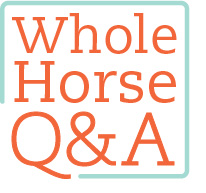
Q I just bought my first horse. Is lip or ear twitching effective in subduing or distracting horses? Is either type of twitching harmful in any way?
SAMANTHA CRESS, Alabama
A During veterinary procedures, it can be necessary to restrain a horse to accomplish a task and avoid injury to human and horse. Twitches have long been a tool for this purpose, applying pressure to either the horse’s lip or ear. Twitching can be done by grasping the horse’s ear or lip with a hand, but most people associate the devices known as twitches with this action, especially when done on the lip.
There are three competing hypotheses about how twitches subdue horses: distraction, pain, or decreased sensitivity. It’s also possible that horses are subdued by combinations of those factors. And some studies have shown that lip twitching subdues horses based on an analgesic (pain-relieving) effect.
Twitches in Action
A 2016 study gave us insight into how horses respond to the lip twitch and the ear twitch, based on the stress indicators of heart rate, heart-rate variability, and cortisol levels. The study measured heart rate and heart-rate variability to assess autonomic nervous-system activity before and during the use of twitches. (Heart-rate variability is the change in time intervals between adjacent heartbeats; variability is considered desirable, suggesting efficiency and health.) The study also analyzed salivary cortisol to assess stress levels before and after twitches were applied.
Twelve geldings—including Quarter Horses, Thoroughbreds, and draft horses, with amedian age of 13—were divided into two groups. Researchers applied lip twitches to one group and ear twitches to the other. Results showed the lip twitch significantly decreased heart rate and increased heart-rate variability when applied for up to 5 minutes. When applied for more than 5 minutes, however, the lip twitch significantly increased heart rate and decreased heart-rate variability. The ear twitch, meanwhile, significantly increased the horses’ heart rate, decreased their heart-rate variability, and increased their salivary cortisol levels—all of which are undesirable responses—when applied for any length of time
The lip twitch, shown to lower heart rate in the presence of painful stimuli and decrease a horse’s reaction to it (see box), is thought to induce the release of beta-endorphins; these subdue horses through an analgesic mechanism, similar to acupuncture.
Though we may conclude that a lip twitch might initially subdue horses through a calming, possibly analgesic effect (at least in the first 5 minutes), an ear twitch clearly evokes a stressed response, immobilizing horses through fear and/or pain.
Immobility achieved by an ear twitch is most likely a freezing response as seen in multiple species, including horses. Ear twitching may also cause damage to the delicate ear tissues.
Moreover, anecdotal evidence suggests horses become head-shy after ear twitching, and more difficult to handle long term.
My own conclusion is that the lip twitch is the only one to use when attempting to humanely subdue a horse, but for no more than 5 minutes. (All analgesic benefits are lost after that point, and an anesthetic should be considered instead.) Ear twitching should be avoided completely
and discouraged among those who handle horses.
KATHERINE HOUPT, VMD, PhD, DACVB
Professor Emeritus Cornell University






